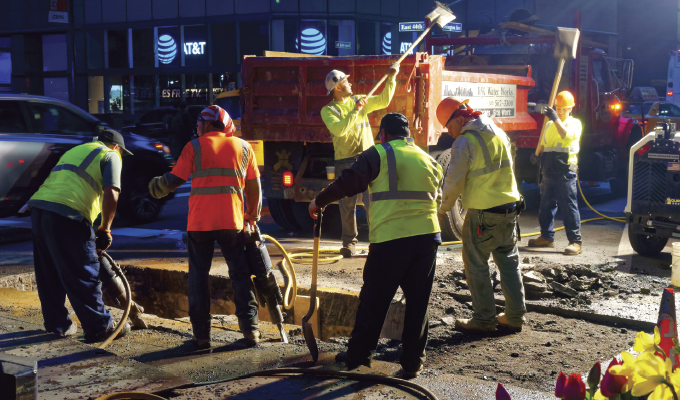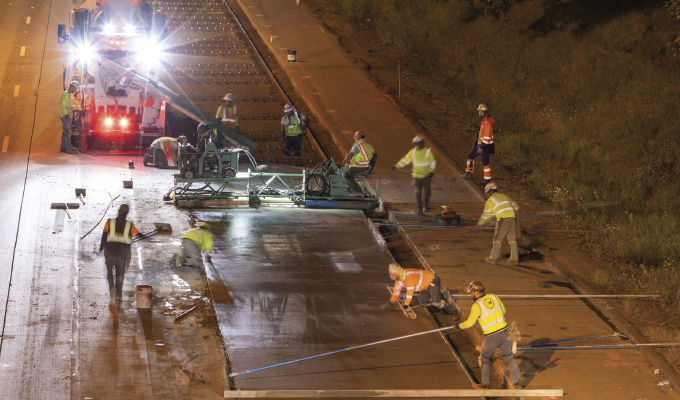The late physicist and Nobel Prize winner Linus Pauling once said, “the best way to have a good idea is to have lots of ideas.” Something similar could be said for work and warning lighting on work trucks, “the best way to have a good lighting environment is to have lots of lighting.”
Pauling was getting at the notion of a conceptual failsafe, where multiple ideas provide backup in case any one idea doesn’t work. This concept begins to illustrate the importance of 360-degree lighting, while only one light might function, multiple lights placed with careful consideration for the entire vehicle’s needs and environment will function much better.
NEED FOR OPTIMUM LIGHTING
The importance of sufficient warning and work lighting isn’t a secret. As any work truck driver, utility crew, or construction worker operating in low light conditions will tell you, “you can’t work on what you can’t see.” The congruent message of this relating to safety on roadways is, “you can’t avoid running into what you cannot see.” Both performance and safety must be considered very carefully to achieve optimum lighting coverage.
A recent report on workplace lighting issued by the International Labor Organization makes clear the importance of correctly installed and optimally functioning work lights, “for close-up work, it is essential to have local lighting where the light shines directly on the task and not into the workers’ eyes.”
This guidance point relates directly to the work truck as well as indoor tasks. Working outdoors in all kinds of weather conditions and varying levels of darkness means mounting angles and lights that are small enough to be mounted in multiple locations are important considerations.
Working on a utility pole at night for example, might mean the work area shifts rapidly from one specific point of operation to another, either changing in location horizontally or vertically. The only way that the work area can stay properly illuminated in that scenario is for either the light to “follow” the worker (good, but time consuming to adjust the light path) or for multiple light installations to properly flood multiple work zones at the same time (better because the work area can change while the sufficient illumination does not).
In terms of safety, multiple lighting sources are also important. While work crews are arriving at the work zone or performing tasks, it’s never fully known from which direction a threat might originate. This means that the entire surrounding “circle” of operation around a vehicle and crew must be considered for safety lighting function.
In addition to placing multiple types of lights around the vehicle, safety lighting, unlike work lighting, should have multiple flash pattern capability, with proper color for the warning function being performed. It’s becoming increasingly common for more vehicles and road signs to use a warning light system. Construction signs now make use of flash pattern LEDs, smaller contractor vehicles often have robust LED warning lights and variable flash patterns, and even consumer vehicles make use of cosmetic LED lighting effects. All this LED proliferation on the roadways makes it trickier to stand out from the crowd and make sure motorists take notice.
While most vehicle warning lights strive to change driver behavior toward a safer outcome, the likelihood that drivers have a certain amount of ambivalence to warning lights remains high. Bright lights are everywhere now, and motorists become acclimated to their presence and numb to the intended effects. So, the question is still, “how can visual attention and the resulting safety it offers be achieved with warning lighting?”
SAFETY AND PERFORMANCE FROM EVERY SIDE
Cutting through “lighting clutter” for safety and providing proper work area illumination is a high priority, requiring a bumper-to-bumper 360-degree approach. Every motorist should be aware of blind spots when checking mirrors before performing a lane change. A quick head check is the workaround to make sure there isn’t a hazard in the unseen space. Unfortunately, with lighting, you can’t predict where a blind spot will be because the location of a potential threat or work zone dark area varies from job site to job site and between several different types of roadway and work zone scenarios.
Therefore, instead of a head check, it’s critical to perform a preemptive “light check” on commercial vehicles. Fleet managers should take the time necessary to consider the entire ecosystem of safety and performance needs their crews will encounter. The next step is to think through the best possible resolutions ahead of time. Underperforming lighting areas or angles on vehicles can then be addressed with proper LED warning and work light installations.

LIGHT STRATEGY — A 360º APPROACH
The goal of warning and work lighting on work trucks should be twofold, first, to send a clear message for safety: this vehicle and crew are on-the-job and must be respected from every side. Second, to illuminate the theater of operation so workers can say: I clearly see what I’m working on, no matter the conditions.
Making the above two points a reality requires high-quality and bright lights, but also, multiple touch points of light. The more strategically placed those points are, the greater the chance for success when it comes to getting the attention of motorists and lighting up dark work environments.
Getting illumination points correct can be achieved by considering the vehicle and its operational environment from a sky view analysis point. This doesn’t mean you need to fly above your vehicle for proper planning, but rather simply visualizing a 360-degree circle of lighting needs around that vehicle can lead to a better understanding of what the threats and dark work area challenges are.
Ask yourself, will spot LEDs be needed at the side of the vehicle to help light up work areas? Will multiple light bars ensure proper warning if the vehicle operates in areas of heavy visual obstruction like city buildings or heavily wooded areas? Will work lights installed in multiple angles save time and make areas around the vehicle safer and more efficient in which to work?
Planning from a bird’s eye vantage point just means a top-down, front-to-back analysis of what lighting choices will bring the best outcomes.
“It’s certainly possible for fleet managers to pick and choose lights from this or that source and work to outfit their vehicles with multiple lighting products from multiple manufacturers, but working with a supplier that offers a complete 360-degree work and warning light portfolio just makes good sense,” said Frank Li, general manager, Opti-Luxx. “The cost savings of having all that planning and production capacity in one place is significant.”
Accomplishing 360-degree lighting coverage isn’t overly complicated. It results in the installation of the right number of LED lights in strategic locations (in accordance with specific municipality light color regulations), ensuring optimum brightness, providing flash pattern variability for safety, and providing an abundance of illumination where work crews will need to perform tasks during low light conditions. It is, as Li suggests, helpful to work with a lighting supplier that offers a broad product portfolio and installation expertise, providing a 360-degree, bumper-to-bumper approach to make sure fleets are safe from every side, and performing at top capacity.
For More Information
Opti-Luxx is a full-service, 360-degree bumper-to-bumper supplier of LED commercial vehicle lighting and offers customers product development, application engineering, program management, launch support for new and existing products, and service after the sale. To learn more, visit www.opti-luxx.com.




